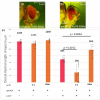The NuA4/TIP60 histone-modifying complex and Hr78 modulate the Lobe 2 mutant eye phenotype
- PMID: 40917779
- PMCID: PMC12412378
- DOI: 10.1515/biol-2025-1164
The NuA4/TIP60 histone-modifying complex and Hr78 modulate the Lobe 2 mutant eye phenotype
Abstract
Gene regulation is important during tissue formation, but redundant systems make it difficult to study in vivo. The protein Jazf-1 is a member of the NuA4/TIP60 histone-modifying complex, and a transcriptional repressor has been suggested to be important for Drosophila melanogaster eye development. We used the GAL4-UAS system to determine the impact of altering gene expression. GAL4-UAS manipulations of Jazf-1 in the eye caused variable and not fully penetrant phenotypes. Increased expression of Jazf-1 has been shown to suppress a Lobe 2 small eye phenotype. We found that Lobe 2 produces a sensitive background for an in vivo assay to monitor gene regulatory complexes. Depleting Jazf-1 and other NuA4/TIP60 complex members significantly enhanced the eye phenotype. We also tested Hr78, which directly interacts with Jazf-1, and found it inversely modifies the Lobe 2 phenotype. An Hr78 mutation predicted to uncouple the Jazf-1 interaction but still capable of interactions with transcriptional activators further enhanced the Lobe 2 mutant phenotype, suggesting the loss of a repressing complex. We believe that Hr78 is acting as an anchor for repressing and activating complexes and the NuA4/TIP60 complex helps repress genes that can negatively impact eye formation in the context of Lobe 2 .
Keywords: GAL4/UAS; Hr78; Jazf-1; enhancer; suppressor.
© 2025 the author(s), published by De Gruyter.
Conflict of interest statement
Conflict of interest: Authors state no conflict of interest.
Figures








References
-
- Omori S, Tanaka Y, Horikoshi M, Takahashi A, Hara K, Hirose H, et al. Replication study for the association of new meta-analysis-derived risk loci with susceptibility to type 2 diabetes in 6,244 Japanese individuals. Diabetologia. 2009;52(8):1554–60. - PubMed
-
- Rees SD, Hydrie MZ, Shera AS, Kumar S, O’Hare JP, Barnett AH, et al. Replication of 13 genome-wide association (GWA)-validated risk variants for type 2 diabetes in Pakistani populations. Diabetologia. 2011;54(6):1368–74. - PubMed
LinkOut - more resources
Full Text Sources
Molecular Biology Databases
Miscellaneous
